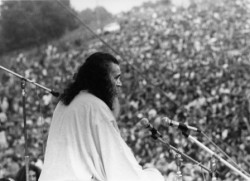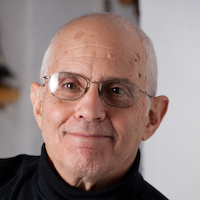Namaste, Swami Satchidananda on Your 100th.
Of all the iconic images of the 1969 Woodstock festival—writhing mud-soaked bodies; impassioned performers like Jimi Hendrix; ecstatic faces and strung-out faces—the one that best captures the era’s zeitgeist is that of Swami Satchidananda addressing the multitude.
It’s a potent symbol of the meeting of East and West that transformed American culture. Forty-five years on, millions of people meditate, chant mantras and stretch on yoga mats, and the late “Woodstock guru” deserves much of the credit. You might want to send him heartfelt a “Namaste” on his birth centennial next week.
On Dec. 22, 1914, the man who became Swami Satchidananda was born C. K. Ramaswamy Gounder. A family man with a successful business in South India, he became a classic wandering ascetic after his wife died tragically young. Several years later, in 1949, he arrived in the holy city of Rishikesh, where he met his guru, the legendary Swami Sivananda, who trained two of the seminal figures in Western Yoga: Swami Vishnudevananda, who arrived here in 1957, and Satchidananda who came nine years later.
In 1966, while teaching in Sri Lanka (then called Ceylon), Satchidananda met an American filmmaker named Conrad Rooks, who flew the Yoga master to Paris, where he was filming a movie called “Chappaqua.” Satchidananda appeared in the rarely-seen film, which also featured the work of two then-unknown artists: composer Philip Glass and painter Peter Max. Max, whose flower-bedecked posters would become the visual backdrop of the hippie era, invited the swami to New York.
It was supposed to be a brief visit, but Max’s hipster friends liked having the guru around, so Satchidananda started teaching in a rented apartment on West End Avenue. He called it the Integral Yoga Institute (IYI), and defined his system as “the complete Yoga, which integrates all aspects of life and maintains our natural condition of an easeful body, peaceful mind, and useful life.” His popularity grew steadily.
In January 1969, he lectured to a packed Carnegie Hall. Seven months later, some of his resourceful students flew him in a helicopter to Woodstock, high above the clogged highways. A casting director could not have found a better person to fill the role of wise elder to 400,000 restless youth. Tall, handsome and stately, with long gray hair and beard, he sat cross-legged on an elevated platform, wrapped in orange, and gently delivered a festival-opening message that resonated with that generation’s sense of importance. “America is helping everybody in the material field,” he said, “but the time has come for America to help the whole world with spirituality also.” He exhorted them not to fight for peace (Vietnam was burning at the time), but to “find peace within ourselves first.”
He offered a taste of exactly that, closing with a traditional Sanskrit chant and a short period of silence. Excerpts of his talk were viewed by millions in “Woodstock,” which won the Academy Award for best documentary.
To this day, many believe that the good vibes generated by Satchidananda averted what might have become a catastrophe when the rains came and food and shelter became scarce. That may or may not be so. But it is certainly true that his presence reinforced the growing awareness that India had something of value to offer the West.
The image of the Hindu holy man blessing the most famous rock festival in history will endure as a symbol of the time when baby boomers turned Eastward and inward.
In the wake of Woodstock, IYI outgrew its West Side apartment and purchased a building in Greenwich Village. It remains a New York fixture. Satchidananda, who died in 2002, spent the rest of his life in the Big Apple and at a thousand acre compound in central Virginia called Yogaville, which continues to thrive as the headquarters of Integral Yoga International and the Satchidananda Ashram.
No one contributed more to the modern Yoga boom than Swami Satchidananda, who started training American teachers in the early 1970s. His legacy is also evident in the growing acceptance of Yoga in the mainstream medical community. Two of his early followers, Drs. Sandra McLanahan and Dean Ornish, have led the way in legitimizing the use of yogic practices in healthcare. There is a direct line between those two physician-researchers and Dr. Oz’s advocacy of Yoga and meditation on national television.
The “Woodstock guru” also left a mark as a tireless emissary for inter-religious harmony. He worked on various projects with representatives of all faiths, speaking up for the Vedic principle that became his motto: “Truth is one, paths are many.” His commitment to that ideal is symbolized by the Light of Truth Universal Shrine (LOTUS), a stunning domed structure at Yogaville that honors all the world’s wisdom traditions.
For his many contributions to the trend lines that are turning America into a nation of yogis, Swami Satchidananda’s 100th birthday deserves to be celebrated.
Love elephant and want to go steady?
Sign up for our (curated) daily and weekly newsletters!
Author: Philip Goldberg
Editor: Renée Picard
Photo: Via the author, used with permission
Ready to join?
Hey, thanks so much for reading! Elephant offers 1 article every month for free.
If you want more, grab a subscription for unlimited reads for $5/year (normally, it's $108/year, and the discount ends soon).
And clearly you appreciate mindfulness with a sense of humor and integrity! Why not join the Elephant community, become an Elephriend?
Your investment will help Elephant Journal invest in our editors and writers who promote your values to create the change you want to see in your world!
Already have an account? Log in.
Ready to join?
Hey, thanks so much for reading! Elephant offers 1 article every month for free.
If you want more, grab a subscription for unlimited reads for $5/year (normally, it's $108/year, and the discount ends soon).
And clearly you appreciate mindfulness with a sense of humor and integrity! Why not join the Elephant community, become an Elephriend?
Your investment will help Elephant Journal invest in our editors and writers who promote your values to create the change you want to see in your world!
Already have an account? Log in.
 Share on bsky
Share on bsky






Read 0 comments and reply